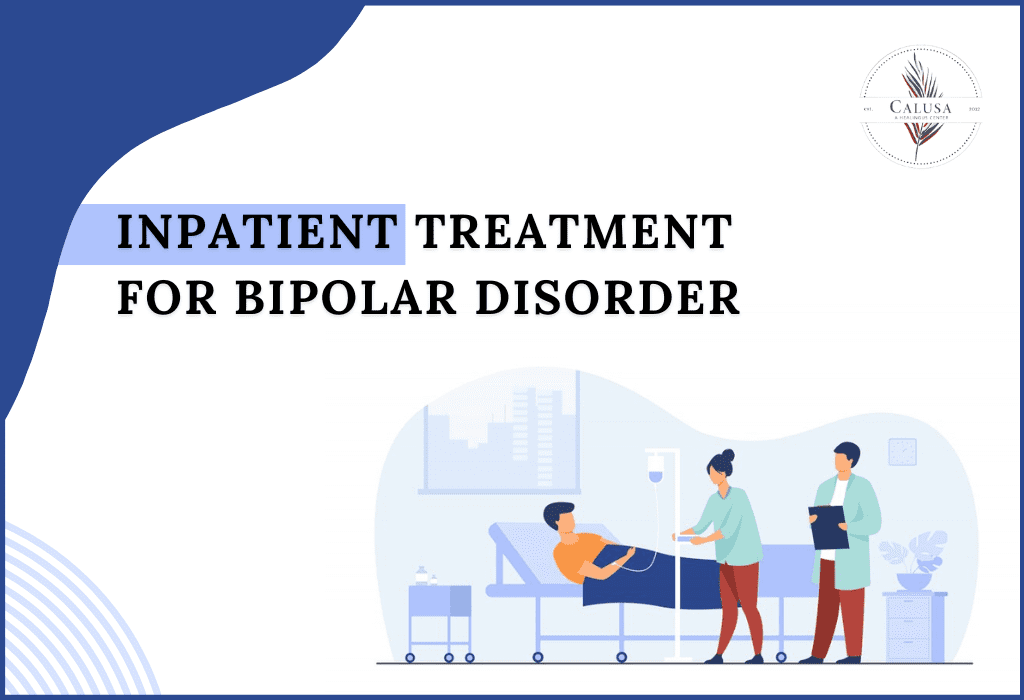Living with bipolar disorder can feel overwhelming, with emotional highs and lows that disrupt daily life. For many individuals, managing these fluctuations is a constant challenge. In these moments of difficulty, finding reliable support is crucial. Inpatient treatment for bipolar disorder can provide the structured help needed to achieve lasting wellness.
Around 2.8% of U.S. adults are affected by bipolar disorder each year. This highlights the need for effective, accessible treatment options. Inpatient care offers a supportive environment that goes beyond symptom management, focusing on creating lasting stability. Let’s explore the often-overlooked benefits of inpatient care and how it can be transformative.
It’s time to heal, to feel better, and to build the future you deserve!
Through personalized therapy like CBT, DBT, and expert care, we’ll work with you every step of the way to manage symptoms and find peace.
The Hidden Benefits of Inpatient Treatment
The majority of people understand that bipolar disorder inpatient treatment is effective because it allows one to receive much-needed support. Still, there are more reasons that make this option life-changing. Here is how committing to inpatient treatment is important for those in search of stability and optimism.
Professional Support 24/7
One of the most important areas is never to be alone without an expert in such difficult times. In such cases, patients are cared for by trained professionals who assist them in every step of their recovery plans without having to wait for them to get assistance.
- Continuous Monitoring: Routine monitoring reduces the likelihood of a crisis occurring while also addressing each patient’s individual needs.
- Tailored Support: Difficulties caused by bipolar disorder can only be experienced through the personalized therapeutic approach delivered in the practice.
Such continuing coverage allows the patients to feel safe and peaceful, which is fundamental to their recovery process.
Structured Routine for Stability
Inpatient treatment for bipolar disorder also has the advantage of a daily or organized structure, which most patients fail to have. This is especially useful as bipolar disorder can thrive on chaos; hence, having a structure will help in the control of the patient’s symptoms.
- Scheduled Therapy Sessions: Therapy is frequent and therapeutically important for emotional wellness.
- Time for Self-Care: Activities such as journaling and mindfulness are carried out daily and are therapeutic in nature.
- Medication Management: Reliable medication schedules minimize setbacks for patients who take their pre-determined medication dosages.
This organization structure goes a long way toward offering the patients meaningful control, which is always important in attempting to promote mental well-being.
Safety and a Trigger-Free Environment
Stress management can be difficult for patients with bipolar disorder. An inpatient treatment for bipolar disorder patients offers a tranquil environment free of stress, allowing the patients to concentrate on the healing process.
- Reduced Triggers: Patients do not have outside pressures and can focus on their recovery.
- Safe Space for Healing: Supportive spaces diminish suicidal behaviors and promote emotional development.
A stronger safety aspect also drives a deeper recovery and, therefore, a better outcome as treatment goes on.
Therapeutic Benefits of Inpatient Treatment
A commonly disregarded benefit of an approach to the inpatient treatment of bipolar disorder is the availability of therapeutical treatments, which guarantees that clients can get the help they require.
Access to Different Therapy Forms
Inpatient care effortlessly instills a variety of therapies in some patients so that individual patients can utilize certain modalities to facilitate their recovery.
- Cognitive Behavioral Therapy (CBT):60 to 80% of patients suffering from bipolar disorder respond well to CBT for control of the symptoms.
- Dialectical Behavior Therapy (DBT): This treatment focuses on emotions, and its use can reduce self-harming behavior by 75%.
- Group Therapy: Working with other people in a therapeutic space reduces the feeling of loneliness.
Being able to choose between different kinds of therapeutic treatments empowers patients to be more resilient to challenges and enables them to handle their emotions better.
Education for Long-Term Management
The emphasis of education within the context of an inpatient setting is very relevant to the management of bipolar disorder in patients following therapy.
- Recognizing Triggers and Symptoms: Patients are taught to spot distinct trigger points and the precursors of moody state shifts. Scientific evidence suggests that identifying the triggers enabled patients to reduce their number of mood episodes by up to 40%.
- Building Stress-Management Skills: Concepts of mindfulness and stress management strategies are no longer concepts but are gained as actual skills for everyday stressors.
- Family Education: It helps to know that familial structures contribute positively to the well-being of patients. Evidence reveals that educational workshops and communication among family members enhance compliance by 50%.
All these help strengthen the educational emphasis and further prepare patients and families to build a long-lasting support system.
Long-Term Benefits of Inpatient Treatment
While inpatient treatment for bipolar disorder focuses on the acute management of the patients, it seeks to set a concurrent culture of the patients thereon.
Building Resilience and Self-Awareness
Inpatient care provides an opportunity for patients to build resilience and self-awareness, which are important for the effective long-term management of the disorder.
- Enhanced Self-Understanding: Patients learn to look at themselves and their actions from a slightly different angle.
- Increased Resilience: Techniques learned in treatment allow the patient to deal with other adversities in an effective manner.
- Support Network Continuation:Several patients continue friendships with some of the inpatients, which is crucial for therapy later on.
These tools are needed to enable a person to be stable and withstand life’s pressures.
Promoting a Healthier Lifestyle
Inpatient treatment for bipolar disorder provides patients the opportunity to make lifestyle changes that reinforce wellness and consistent mood.
- Regular Exercise can significantly boost enthusiasm for an activity such as sport. Consistent exercise can improve mood and energy levels. An overview of research suggests that engaging in physical activities can decrease depressive and anxious symptoms by as much as 40%.
- Nutrition: Well-balanced meals also promote emotional health and provide the energy that is needed.
- Improved Sleep Habits: Patients learn to improve their sleeping and waking times, which is important for mood control.
Such lifestyle changes will prepare patients to live healthier lives and assist in maintaining mental health.
Your Journey to a Brighter Tomorrow
FAQs
Q: What is the average age of death for someone with bipolar disorder?
A: Compared to the general population, individuals with bipolar disorder have a life expectancy gap of 9.2 years on average. Suicide risk factors, substance abuse, and a myriad of medical complications all seem to enumerate this gap.
Q: What is end-stage bipolar disorder?
A: End-stage ‘bipolar’ can be characterized by the overwhelming feeling of ‘persistence’, which embodies the actual definition of the term. Individuals with this condition often have severe oaths that chronically disrupt their mental capacities and emotions, making it necessary to alleviate their condition so as to avoid worsening the health status of the individual.
Q: Why do people get hospitalized for bipolar?
A: Hospitalization for bipolar disorder typically occurs during severe manic or depressive episodes. These situations may involve risk to oneself or others, inability to care for oneself, or lack of adequate outpatient support, requiring intensive treatment and stabilization.
Q: What is the success rate of bipolar treatment?
A: Bipolar treatment success rates are ‘averagely up there.’ There are widespread ranges across the statistics due to fewer or, at times, negative outcomes. Upwards of 80% of the patients would respond to treatment, especially if they were prescribed medication along with therapy. Early intervention and case-specific techniques increase the chances of sustained control.
Q: What is the number one cause of death in bipolar disorder?
A: The number one cause of death in bipolar disorder is suicide, and this takes 25 – 50 % of all deaths. Other risks tend to be cardiovascular diseases and even accidental overdoses from drugs, which indeed is commonplace in substance abuse depression.
Q: Why does bipolar disorder shorten lifespan?
A: Lifespan may be shortened as a result of high suicide rates, alcohol or substance use, heart disease, or other related comorbidities. Stress from work and family, a life that is always on the go, and the use of medications also lead to a worse health outcome.
Conclusion
Why Inpatient Treatment is a Strong Choice for Bipolar Disorder for Patients Today For people who live with bipolar disorder, it is said that people are highly prone to the condition and look for inpatient treatment as more than a change of environment. They seek an opportunity for growth, development, and stability, regardless of how big or small. With focus, systematic delivery of care, various therapies, and resources to improve patient outcomes, the effectiveness of inpatient treatment for bipolar disorder is ideal for long-term recovery and balance.
At Calusa Recovery, we advocate for effective outpatient or inpatient care for stabilization. Our programs are ideally designed to assist with this process. If you are interested in learning how you can enjoy the benefits of the program, we encourage you to reach out today.










